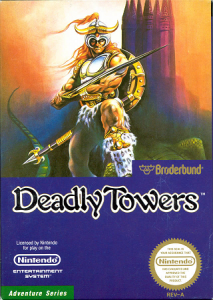At the end of 1986, Lenar’s Deadly Towers was released in Japan, followed by an American release the following September. Yet, despite the release coming near the end of the year, Deadly Towers was nevertheless a best-selling title on the NES in 1987. Of course, these were early days for role-playing games on Nintendo’s console, which was yet emerging in terms of its popularity. Clearly the success of the game owes more to the dearth of available RPGs than to its content, because what Deadly Towers doesn’t have is satisfying music, sound effects, gameplay, plot, characterisation, graphics, or, indeed, anything else.
The gameplay is generally typical of NES-era, top-down adventure games. The player controls Prince Myer, a knight, who appears to be clad in some sort of bluish hoodie. The Prince of the Hoodlums has been set a task (according to the instruction manual) by a spirit, who has revealed to him (also in the instruction manual) that Myer’s Kingdom of Willner will be destroyed by an army of demons led by the fearsome Rubas. To prevent this deeply unpleasant situation coming to pass, Myer must sally forth to the mountains of the north and destroy the seven sacred bells in the sacred flame–after which he must destroy Rubas (with a sword, not the sacred flame). Prince Myer leaps into action; his coronation is on the morrow (so the instruction manual relates), and he can’t allow the festivities to be ruined by something as disagreeable as the end of the world. Morover, in Myer’s little Germanesque country, the coronation is probably heralded by the Teutonically officious execution of their ethnic minorities; Myer musn’t delay or the demons may bump off his intended targets first!
Desperate to ensure that his thousand-year-rule gets off to a ringing start, Myer dons his sacred blue hoodie and picks up his dirk. There are demons to slaughter. Unfortunately for Prince Myer, staying awake all night (as the instruction manual claims he does) to contemplate the future of his kingdom has left the young dictator feeling a trifle groggy. Luckily for gamers, Lenar has a keen eye for this sort of detail, and they have made Prince Myer extremely difficult to control. He slowly plods through the land, throwing little knives that travel only slightly slower than an upset tortoise. But Myer is not irresponsible!–to ensure that each knife meets its target, he refuses to throw another knife until the first has landed. Thus, with one knife on the screen at a time, the plodding prince perambulates persistently towards his pious purpose.
Upgrades may be found–but not easily. For purchaseable upgrades are hidden in dungeons, and by hidden this reviewer means hidden. The entrances to the dungeons are completely invisible; as are the exits from those dungeons within the dungeons themselves. Within the dungeons, the exits are in different rooms than their entrances. Moreover, all of the dungeons wrap around–and, their layout is what some might be willing to call ‘excessively confusing to the point of insanity’. A player could easily blunder into a dungeon purely by accident and never find the way out–for the room the player enters in is not the room the player can exit from. Each room is full of monsters which respawn, and Prince Myer has virtually no way to recover his life. When he dies, the game restarts. He will likely die long before he reaches the exit of the dungeon: the first dungeon has 167 screens whilst the last has nearly half as many again.
If Myer is slow, and his sword slower, the enemies of Deadly Towers are not at all so encumbered. Moving with great accuracy and speed, no doubt as a result of being rested for millennia, the demons flap and flutter around the screen entirely unpredictably. Curiously, Deadly Towers has an extremely well developed randomiser. Unfortunately, this renders the game nearly impossible. Enemies move much faster than Prince Myer’s floating butter knife and they also move in entirely unpredictable ways. Rewinding the game in emulation will result in different enemy behaviour each time, so that the game is teeth-gnashingly difficult even with an unlimited ‘undo’ feature. Meanwhile, the repetitive beeps and boops which pass for a soundtrack grind endlessly into the mind of the player, cutting sawtooth grooves along the neural pathways until screaming, endlessly screaming, seems the only escape. The NES was capable of wonderful soundtracks–the Mega Man games, for example, prove this point. Deadly Towers does not have a wonderful soundtrack. It is an auditory torture chamber in which the player is immersed and then ground slowly into dust.
As Myer works his way through the castle, the mountains, the dungeons, the cave, and eventually the towers, he may blunder into a secret ‘Parallel Zone’–a gateway to which exists in each of the towers. In the Parallel Zone, Myer can get equipment which is usually helpful. An exception is the double shot, which shoots two daggers instead of one, and which cannot be shut off. This might seem like a positive boon, but one of the daggers always seems to miss the intended target, leaving the player forced to wait until the other dagger finally ambles to the edge of the screen–only then can the player shoot again. The entrances to the Parallel Zone are as invisible as those to the dungeons–and their exits likewise. It is entirely possible to get lost in the Parallel Zone and never find one’s way out unless one is capable of stepping in literally every available place in the hope of finding the one place which will teleport the player out.
The bosses in Deadly Towers have a load of life and take forever to kill–and the final boss has several forms with a significant degree of randomisation to it. As Myer cannot recover his life by any means other than killing normal enemies and hoping for a life-up–and as these do not exist in boss fights–the battle system may be accurately described as ‘punishing’, ‘unforgiving’, and ‘bloody awful’. The reviewer was forced to rewind battles thousands of times until, through sheer luck coupled with manual dexterity, he managed to just squeak through to victory–after which he was forced to descend the entire tower, burn the bell, and repeat the process for the rest of the seven towers which comprise the areas before the final tower itself.
A note on the combat: Prince Myer is not rendered temporarily immune when struck–not even for a moment–though he is knocked back. With monsters that move quickly, Prince Myer can be knocked into the monster itself, and again, and again, so that he can be killed from full life to naught in less than two seconds. For, once hit, Myer cannot be controlled again for a full second or more. Worse yet, the game is full of ‘Deadly Ledges’, which Myer (in his sleep-deprived state) will plunge down if he gets anywhere closer than, say, thirty yards. This results in an instant game-over as well. Monsters can (and will) knock Myer over these ledges, making the chasms far more dangerous than any enemy in the game. Also, bosses respawn–including the mini-bosses in the opening section of the game. Going back through a door that had a boss in front of it will place Prince Myer squarely inside that boss, usually killing him before the player has realised their blunder.
The rooms and the monsters all look the same, and the bosses are all badly-animated chimeras which leave little impression upon the player (there was a ghost, and a hydra… maybe?). The music is the NES equivalent of an industrial estate’s ambience, the difficulty level is sufficient to wring tears from the most hardcore gamer’s eyes, and the controls are the digital equivalent of trying to pilot Nate Liles through a ball pit whilst hanging on his back, shouting directions into his Lady Gaga-deafened ears. Meanwhile, the littlest Teutonic prince has no in-game backstory and what we do get–from the instruction manual–is the most barebones of outlines, none of which is referenced in the game. And when the game is completed, the player gets a single screen of congratulations in text, along with a picture of the future genocidal maniac secure on his throne, waiting to deport undesireable segments of his population to the work camps where they can be made to produce for the Fatherland and then be made to disappear.
In short, Deadly Towers is a bad game. But more than that, it is the worst game which Lusipurr has played in many years of playing terrible games. Avoid it–avoid it like the plague it surely is. Avoid it if you value your sanity. Avoid it if you enjoy games. Avoid it because, for a game that actually works, it is amazing how the fine people at Lenar have managed to get everything wrong. Other broken games have done worse–but they are broken. Deadly Towers is not broken and, in the end, that removes any excuses it may have had.





